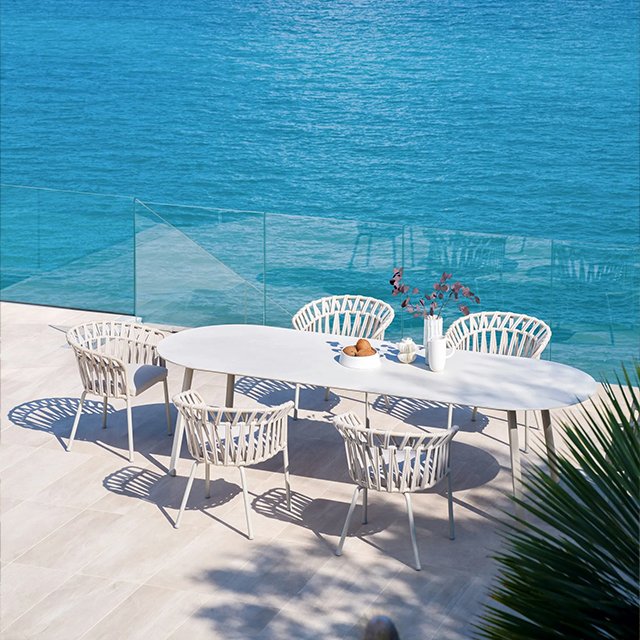Choosing the right material for your outdoor dining chairs is crucial for ensuring both comfort and longevity. At Outdoor Whale Furniture, we offer a wide range of materials to suit various styles and needs. Here, we compare the most popular materials used for outdoor dining chairs to help you make an informed decision.
1. Wood
Pros:
- Natural Aesthetic: Wood offers a timeless and elegant look that blends seamlessly with nature.
- Durability: High-quality woods like teak and eucalyptus are resistant to weather and insects.
- Comfort: Wooden chairs are often comfortable and can be easily customized with cushions.
Cons:
- Maintenance: Requires regular maintenance such as sealing and oiling to prevent weather damage.
- Cost: High-quality wood can be expensive.
Best For:
- Traditional and rustic outdoor spaces.
- Those willing to invest time in maintenance for longevity.

2. Metal
Aluminum
Pros:
- Lightweight: Easy to move around.
- Rust-resistant: Doesn’t rust, making it ideal for all weather conditions.
- Low Maintenance: Requires minimal upkeep.
Cons:
- Heat Retention: Can get hot in direct sunlight.
- Stability: May not feel as sturdy as heavier materials.
Best For:
- Modern and minimalist outdoor spaces.
- Areas with high humidity or frequent rain.
Steel
Pros:
- Strength: Very durable and can support heavier weights.
- Design Variety: Available in many styles and finishes.
Cons:
- Rust: Prone to rust if not properly coated.
- Weight: Heavier and harder to move.
Best For:
- Urban and industrial-style outdoor areas.
- Environments where sturdiness is essential.

3. Wicker
Natural Wicker
Pros:
- Aesthetic Appeal: Offers a charming and cozy look.
- Comfort: Naturally flexible, providing a comfortable seating experience.
Cons:
- Weather Sensitivity: Prone to damage from moisture and UV rays.
- Maintenance: Requires regular upkeep and protection from the elements.
Best For:
- Covered patios and sunrooms.
- Those looking for a classic and comfortable seating option.
Synthetic Wicker (Resin)
Pros:
- Weather-resistant: Highly resistant to moisture, UV rays, and temperature fluctuations.
- Durable: Long-lasting and requires minimal maintenance.
Cons:
- Less Authentic Look: May not have the same natural appeal as real wicker.
- Potential Fading: Lower quality resin can fade over time.
Best For:
- Any outdoor space, especially those exposed to the elements.
- Those seeking a low-maintenance option with a classic look.

4. Plastic
Pros:
- Affordability: Generally the most cost-effective option.
- Lightweight: Easy to move and stack.
- Low Maintenance: Requires little to no maintenance and is easy to clean.
Cons:
- Durability: Less durable than other materials, prone to cracking and fading.
- Aesthetic: Can look less sophisticated compared to other materials.
Best For:
- Budget-conscious buyers.
- Temporary or secondary seating options.
5. Fabric (Sling Chairs)
Pros:
- Comfort: Fabric provides a comfortable and breathable seating option.
- Variety: Available in many colors and patterns.
Cons:
- Durability: Fabric can wear out or fade over time, especially in harsh weather conditions.
- Maintenance: Requires cleaning and potential replacement of the fabric over time.
Best For:
- Comfortable, casual seating.
- Areas with partial shade to extend fabric life.
Conclusion
When choosing the material for your outdoor dining chairs, consider factors such as durability, maintenance, aesthetics, and comfort. Each material has its unique advantages and potential drawbacks.
At Outdoor Whale Furniture, we offer a wide range of outdoor dining chairs crafted from the finest materials to suit any style and need. For more information or personalized recommendations, visit our website or contact us at info@ligointl.com. We’re here to help you create the perfect outdoor dining experience!



